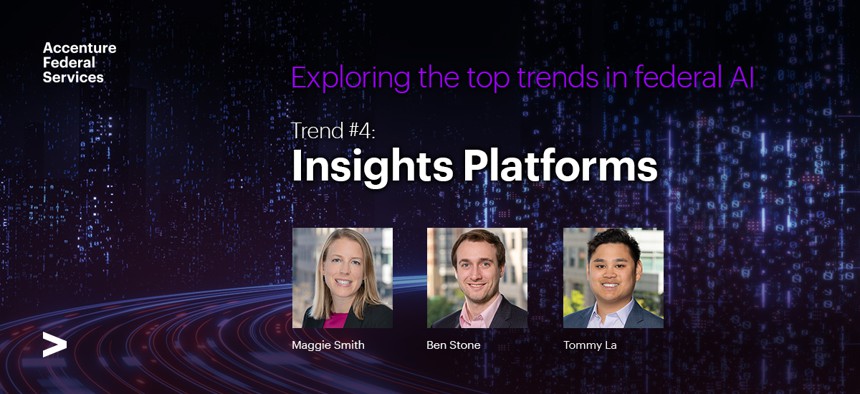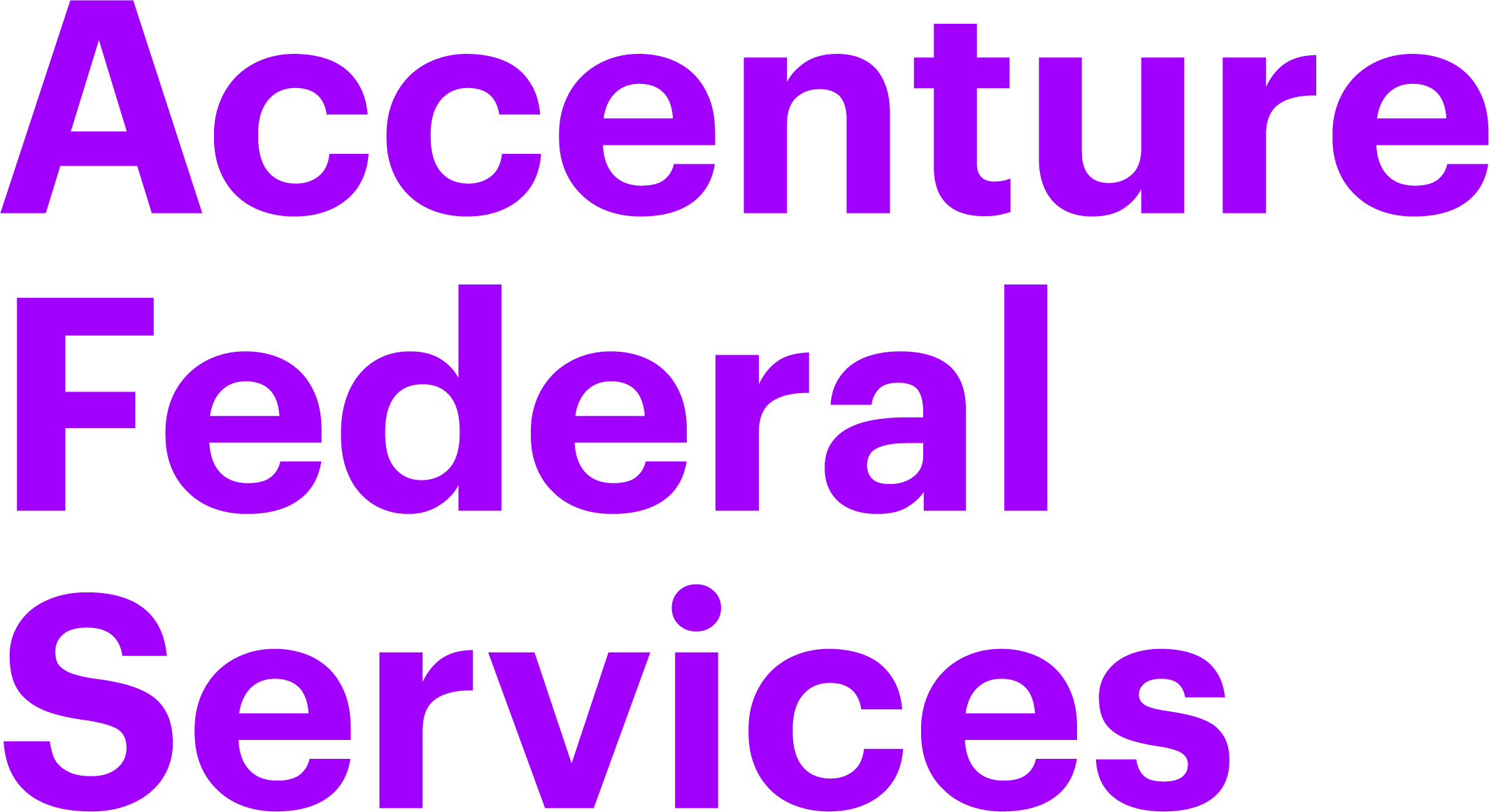sponsor content What's this?

Insights Platforms: A scalable foundation for data-driven decision-making
Insights platforms provide a streamlined, scalable data foundation resulting in broader data access and value for federal agencies.
Presented by
Accenture Federal Services

The 2018 Foundations for Evidence-Based Policymaking Act tasked federal agencies with making their data more accessible, and encouraged them to use evidence for “agency operations, grantmaking, human capital management and development, and program administration, as well as to support mission strategic areas, like program and service delivery.”
Using data to inform decisions at all levels can positively transform government. However, achieving this widespread adoption will require agencies to break down data silos and improve cumbersome, inefficient analysis tools and processes.
Chief data officers and other data leaders need powerful but easy-to-use systems that combine discovery and analysis to generate actionable insight. More specifically, they require modern insights platforms that can bring together advanced data fusion capabilities with AI and machine learning-based analysis, all within a single intuitive environment. Using insights platforms, executives can more readily integrate and analyze the full scope of their data and effectively implement AI to achieve measurable results.
Insights platforms are already paying significant dividends for federal agencies. For example, USDA launched its Enterprise Data Analytics Platform and Toolset (EDAPT) to integrate the use of AI across its 29 agencies and staff offices, and nearly 100,000 employees. A report from the Advisory Committee on Data for Evidence Building noted that, “These initial investments have enabled partnerships across department, mission area, program area, Statistical Official, CDO, and Evaluation Officer functions that substantially advance the department’s evidence-building capacity both internally and externally.” According to the Advisory Committee on Data for Evidence Building’s report, EDAPT supported a more efficient and effective response to the COVID-19 pandemic by enabling USDA to rapidly develop relevant dashboards that provided insight into workforce safety, as well as how to adjust program delivery to still meet citizens’ needs despite the upheaval.
Benefits of insights platforms
Through our work with federal agencies, we’ve seen firsthand the benefits of insights platforms, which extend across the key roles involved in an agency’s use of AI:
For IT administrators and engineers, insights platforms provide a well-architected environment that allows greater ease of administration. These solutions are pre-configured and ready-for-use, bringing together the best of industry – including cloud native, open source, and commercial tools – in an intelligent way. This can help avoid lengthy enablement timelines and technical debt resulting from sub-optimal tooling or configurations.
In particular, insights platforms can help agencies optimize performance and security. Deploying AI can be resource intensive in terms of both storage and processing. An insights platform helps balance loads by leveraging cloud autoscaling capabilities and performance monitoring/altering to optimize compute resources.
Insights platforms also bake-in 24/7 security with features for security logging, monitoring, and alerts, as well as access authentication including RBAC and ABAC. A hardened and compliant security boundary expedites ATO and can ensure the government feels confident in storing its unique data and insights.
For data scientists, insights platforms provide a shared environment to conduct analysis more efficiently and collaborate more effectively. Data sources from across the enterprise are presented in one common platform, helping break down data siloes and enabling organizations to harness the full power of their shared data assets. Then, data scientists can more easily use their tool of choice, deploying their models to a readily available production environment.
In addition to this supercharged analysis, insights platforms can help foster a thriving data community within the organization as passionate data practitioners can collaborate, share code, and avoid the many frustrations that come with performing data science work on a local workstation. With an insights platform, organizations can establish a library of commented code for anyone to access; everything that someone creates can then go into the library, to be reused or improved for the whole organization’s benefit.
Lastly, business and executive-level decision-makers can use insights platforms to consume analytical insights more easily and effectively. Citizen data scientists can take advantage of AI tools with drag-and-drop ease, to apply insight more readily to the mission. Executives have access to dashboards and field reports that provide greater visibility into the full scope of an agency’s data. These platforms can then cyclically consume the data and insight generated, providing more informed decision-making with each turn.
With the entire workforce engaged in one environment, the insights platform becomes the “single source of truth” for the agency’s data, increasing the efficiency of the data applications and infrastructure.
How to get started?
An insights platform is useful for an agency no matter where they are on their data maturity journey. For those just starting out, the platform provides a powerful launching point toward greater data integration and visibility, and deeper insight. For those with preexisting capabilities, an insights platform can provide a more optimized way to manage your current configuration. This can potentially decrease hosting and processing costs and allow more rapid adoption of new technologies and data sets.
As in all technology transformations, the implementation of insights platforms will be most successful when IT works in tandem with the business—and in direct response to business needs. Don’t presume a solution or vendor. Start with identifying the outcomes you are looking to create, then use those outcomes to determine the best platform for your needs.
Focus initially on small-scale use cases that can demonstrate clear mission value. When use grows, an insights platform can then accommodate dynamic scaling up and down to meet current needs and optimize cost, helping maximize return on investment.
As federal agencies continue to adopt and scale AI amid rapidly shifting technology environments, insights platforms can serve as a consistent foundation — helping you stay flexible and agile while driving measurable results.
Authors:
- Maggie Smith | Managing Director, Applied Intelligence | LinkedIn
- Ben Stone | Senior Manager, Applied Intelligence | LinkedIn
- Tommy La | Managing Director, Applied Intelligence | LinkedIn
This is part of a series by Accenture Federal Services on the top four trends building the future of federal AI.
This content is made possible by our partner, Accenture. The editorial staff was not involved in its preparation.
NEXT STORY: Inside the Department of Energy’s AI Risk Management Playbook






